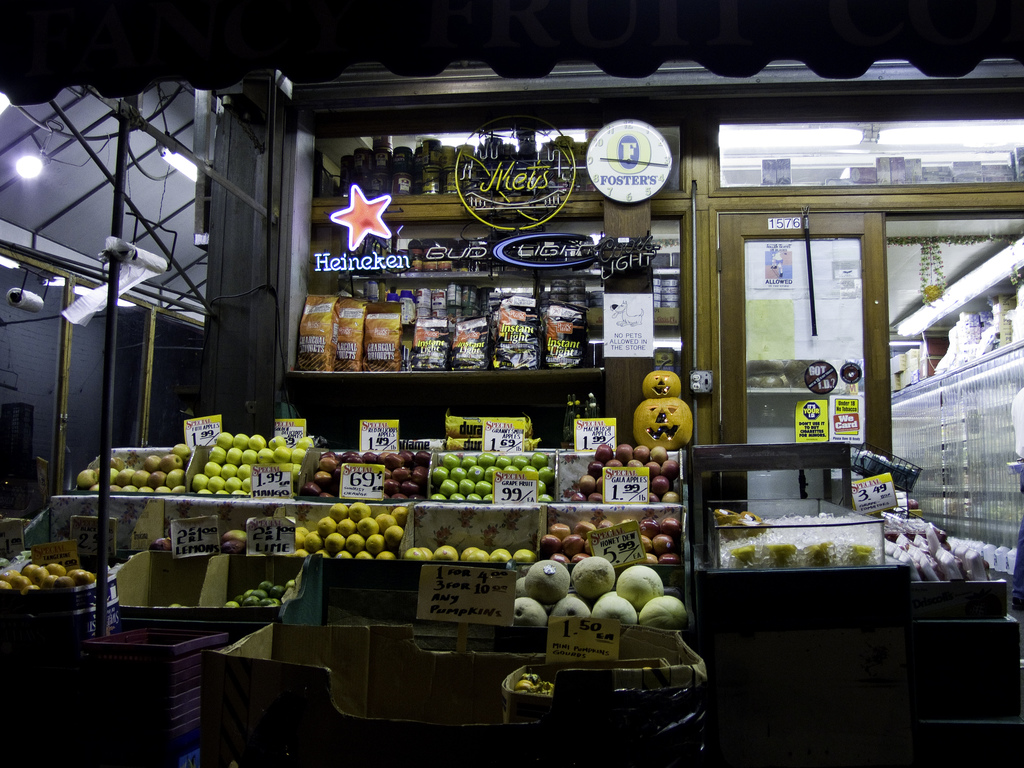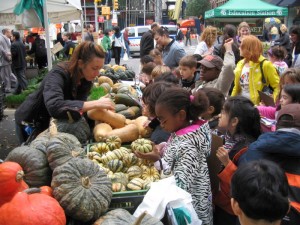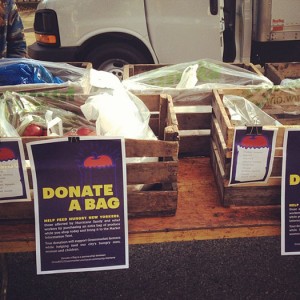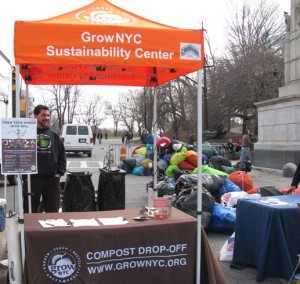Farmers’ Markets
Urban Hubs
Offering products as diverse as the city itself, farmers’ markets in New York City benefit both urban consumers and rural producers by providing an alternative food source. The organization GrowNYC runs fifty-four farmers’ markets throughout the city where families and foodies can come together in the name of food with celebrity chefs and countercuisine supporters, those who favor ethical, local, seasonal, and organic food. These Greenmarkets, as they are called, provide a gathering space for consumers and producers of all backgrounds.
A Different Kind of Market
Union Square (New York City), Greenmarket Farmer’s Market – Travel Video PostCard™, https://www.youtube.com/watch?v=uWUfYjjCZVI, May 19, 2012, video by Travel Video PostCard.
As an alternative to omnipresent supermarket chains, farmers’ markets give New Yorkers access to fresh, high-quality food products that come directly from the farmers who grow them. Their customers value both the quality of food and also the knowledge of its origins. Independent producers offer a wide variety of produce and have direct control over the quality of the food they sell. The markets make up for the dearth of seasonal local produce in supermarkets and the unavailability of specialized ingredients desired by the city’s many ethnic communities.
In addition to increasing profits for small growers, farmers’ markets actively support farmland preservation. To date, 30,000 acres of agricultural land have been protected from urban development through the Greenmarkets program. To safeguard both producers and consumers, vendors follow strict rules, including the stipulation that all products must come from metropolitan farmland, or farms that are within a 120-mile radius of NYC.
Access and Affordability
Fresh Bodegas, New York, NY, photograph by hi-lo, October 20, 2007, courtesy of Flickr.
The purpose of the food justice movement is to increase New Yorkers’ access to fresh, nutritious food, regardless of their social or economic background. The Greenmarkets have targeted food deserts in Harlem as places in need of farmers’ markets, but opening a market does not always have positive results. The gentrification that follows the establishment of a farmers’ market can hurt the population that needs it the most. Critics also warn that the markets can put local stores out of business, and that market vendors are increasingly catering to the tastes of affluent consumers rather than to low-income populations. However, through programs such as Fresh Bodegas, in which farms deliver their produce to low-income neighborhoods for sale in local stores, the Greenmarkets are working to expand access to underserved populations.
Despite their successes, the Greenmarkets have been unable to reconcile their original goals of quality and affordability. Farmers’ markets are significantly more expensive than supermarkets. The most effective means of increasing affordability at the Greenmarkets is the acceptance of Electronic Benefit Transfer cards (EBT). Nearly every Greenmarket accepts these benefits, and the program also gives a two-dollar credit for every five dollars of benefits spent. However, the Greenmarkets are still inaccessible to families in the middle—those who do not qualify for EBT but are priced out of the markets.
A Community of Consumers
Community at the Greenmarkets, New York, NY.
Farmer’s markets offer space for more than shopping. They are urban hubs with a small-town feel, a place to which many shoppers return because of their personal relationships with farmers. To increase their positive impact on the community, vendors donate close to a million pounds of produce each year to NYC food banks and food pantries. The Greenmarkets also offer cooking and nutrition classes wherein New Yorkers can learn about healthy eating habits. Devoted to education, GrowNYC organizes field trips for students to both the markets and local farms, in an effort to create a new generation of responsible and informed consumers.
The Greenmarkets act as an access point to sustainable practices by providing centers where shoppers can safely drop off their recyclables as well as organic materials to be turned into compost. For example, GrowNYC is a major advocate for the recycling of textiles. Local artisans such as fiber artist Laura Sansone, who uses compost to create natural dyes, bring even more dynamism to the markets by allowing consumers to engage with food in entirely new ways. – M.M.C.






